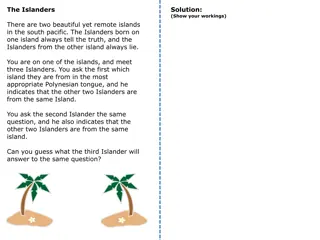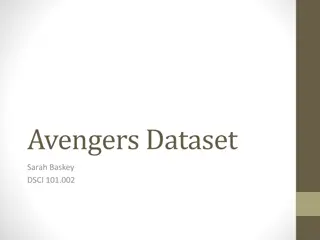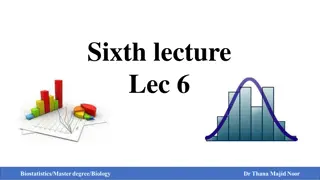Data Cleaning
Data cleaning is the process of fixing or removing incorrect, duplicate, or incomplete data within a dataset. It improves data quality, ensuring accurate and reliable information for decision-making. Learn why data cleaning is necessary and the essential reasons to clean your data.
4 views • 35 slides
HyPoradise: Open Baseline for Generative Speech Recognition
Learn about HyPoradise, a dataset with 334K+ hypotheses-transcription pairs for speech recognition. Discover how large language models are used for error correction in both zero-shot and fine-tuning scenarios.
4 views • 16 slides
Understanding UKMOD: UKHLS Input Data Analysis
UKMOD-UKHLS is a versatile dataset derived from the UK Household Longitudinal Study (UKHLS) for policy years 2010-2019. It aims to provide valuable insights for longitudinal analysis in the UK. The dataset undergoes meticulous processing to align with policy years, address data gaps, and deliver acc
0 views • 12 slides
Understanding Supervised Learning Algorithms and Model Evaluation
Multiple suites of supervised learning algorithms are available for modeling prediction systems using labeled training data for regression or classification tasks. Tuning features can significantly impact model results. The training-testing process involves fitting the model on a training dataset an
3 views • 74 slides
Desert Adaptations: Animals and Habitat Survival
Habitats play a crucial role in the survival of animals, especially in harsh environments like deserts. Explore the unique adaptations of animals like camels and learn how they are perfectly suited to thrive in hot, arid conditions. Understanding these adaptations is key to appreciating the diversit
0 views • 16 slides
Understanding Bovine Theileriosis: Causes, Symptoms, and Prevention
Bovine theileriosis is a tick-borne haemoprotozoan disease that causes significant economic losses in livestock due to high mortality rates, weight loss, abortion, and reduced milk yield. The disease is characterized by fever, anemia, and respiratory and digestive disorders. It is caused by parasite
1 views • 11 slides
Understanding Partition Values in Statistics
Partition values such as quartiles, deciles, and percentiles play a crucial role in dividing a dataset into various segments for analysis. Quartiles split the data into 4 equal parts, deciles into 10 parts, and percentiles into 100 parts. These values help in understanding the distribution of data a
0 views • 7 slides
Korean Peninsula Issues and US National Security Polling Findings
This polling dataset explores various questions related to the Korean Peninsula issues and US national security. It delves into topics such as the stances of the Biden and Moon administrations towards the Kim regime, potential agreements to address North Korea's nuclear issues, success of the Korea
0 views • 16 slides
Streamflow-Based Analysis for Climate Change Impact Detection and Attribution
This study focuses on detecting and attributing climate change impacts using a multi-basin, multi-model approach. It utilizes the CAMELS dataset, including observed data from 671 gauges across the USA, to analyze streamflow changes and seasonality shifts. The methodology involves updating datasets,
1 views • 7 slides
Setting up and Running Postal Code Conversion File Plus (PCCF+) - Step-by-Step Guide
In this detailed guide prepared by Statistics Canada, you will learn how to set up and run the Postal Code Conversion File Plus (PCCF+). The process involves creating an input file with unique identifiers and postal codes, producing a new dataset, saving it for import, importing the data to SAS, tra
0 views • 21 slides
Challenging Logic Problems and Riddles Collection
Collection of diverse logic problems and riddles ranging from camels on a narrow ledge, mislabeled fruit boxes, river crossing with cannibals and anthropologists, a puzzling age dilemma, a life-threatening choice with deceptive robots, to a frog escaping a well through calculated leaps. Put your cri
0 views • 10 slides
Active Object Recognition Using Vocabulary Trees: Experiment Details and COIL Dataset Visualizations
This presentation explores active object recognition using vocabulary trees by Natasha Govender, Jonathan Claassens, Philip Torr, Jonathan Warrell, and presented by Manu Agarwal. It delves into various aspects of the experiment, including uniqueness scores, textureness versus uniqueness, and the use
0 views • 49 slides
Best Practices for Rectal Palpation in Veterinary Medicine
Rectal palpation is a crucial diagnostic method in veterinary medicine for assessing the reproductive health of animals like cows, buffaloes, mares, and camels. This technique helps in determining the normal and abnormal conditions of genital organs, aiding in pregnancy diagnosis and differentiating
0 views • 18 slides
Machine Learning Techniques: K-Nearest Neighbour, K-fold Cross Validation, and K-Means Clustering
This lecture covers important machine learning techniques such as K-Nearest Neighbour, K-fold Cross Validation, and K-Means Clustering. It delves into the concepts of Nearest Neighbour method, distance measures, similarity measures, dataset classification using the Iris dataset, and practical applic
1 views • 14 slides
Enhancing Image Disease Localization with K-Fold Semi-Supervised Self-Learning Technique
Utilizing a novel self-learning semi-supervised technique with k-fold iterative training for cardiomegaly localization from chest X-ray images showed significant improvement in validation loss and labeled dataset size. The model, based on a VGG-16 backbone, outperformed traditional methods, resultin
0 views • 5 slides
Tricky Islander and Camel Puzzles
In the first scenario, you encounter truth-telling and lying Islanders on remote islands, trying to deduce the origin of each one based on their statements. The solution reveals the pattern of responses. The second puzzle involves Tasmanian camels on a ledge, navigating a tricky situation where they
0 views • 8 slides
Challenging Puzzles: Islanders, Camels, and Cubes
Engage your mind with three intriguing puzzles - deciphering truths from lies on remote islands, orchestrating the passage of Tasmanian camels on a narrow ledge, and solving the cube mystery of displaying dates. Test your logic and problem-solving skills with these brainteasers!
1 views • 12 slides
General Medical Imaging Dataset for Two-Stage Transfer Learning
This project aims to provide a comprehensive medical imaging dataset for two-stage transfer learning, facilitating the evaluation of architectures utilizing this approach. Transfer learning in medical imaging involves adapting pre-trained deep learning models for specific diagnostic tasks, enhancing
0 views • 16 slides
Best Practices for Dataset Handling in Machine Learning Projects
Proper dataset handling is crucial in machine learning projects. Use publicly available datasets with train/dev/test splits or create your own. Be cautious of overfitting by utilizing independent validation and test sets. Avoid touching the test set until final evaluation to prevent overfitting. Mai
0 views • 13 slides
The Noble Camel: General Information, Physical Characteristics, Habitats, Behaviors, and Interesting Facts
The Camelus Dromedarius, known as the camel, has distinctive characteristics such as its hump(s) for storing fat and surviving in deserts and semi-arid grasslands. Camels can endure extreme heat, lack of water, and can go months without drinking due to their unique adaptations. They are herbivores,
0 views • 6 slides
Insights from Avengers Dataset
Dataset analysis of Avengers' appearances, gender, status, and years since joining. Obtained from data.world, the dataset consists of 173 records capturing various details about Avengers characters. Methods for examining appearances, gender distribution, status types, and years since joining were ap
0 views • 14 slides
Understanding Measures of Central Tendency in Math
In mathematics, the average, median, mode, and range are essential measures of central tendency used to organize and summarize data for better understanding. The mean refers to the middle value of a dataset without outliers, while the median is the middle number when the data is ordered. The mode re
0 views • 14 slides
Maximum Load Guidelines for Draught and Pack Animals
Dr. Ranveer Kumar Sinha, an Assistant Professor cum Junior Scientist at Bihar Veterinary College, provides guidelines on the maximum load capacity for draught and pack animals, including bullocks, buffalos, horses, ponies, mules, donkeys, and camels. The document outlines specific weight limits base
0 views • 11 slides
WikiQA Dataset: Open-Domain Question Answering Challenges
WikiQA Dataset provides a challenge for open-domain question answering, focusing on identifying answers from large-scale knowledge bases such as Freebase and high-quality text sources like Wikipedia. The dataset includes questions sampled from search engine query logs, with candidate sentences sourc
0 views • 24 slides
Open-Domain Question Answering Dataset WikiQA Overview
This content discusses the WikiQA dataset, a challenge dataset for open-domain question answering. It covers topics such as question answering with knowledge base, answer sentence selection, QA sentence dataset, issues with QA sentence dataset, and WikiQA dataset details. Various aspects of open-dom
0 views • 24 slides
Understanding YouTube Video Trends: Dataset Analysis by Grace Dimmer
Explore the factors influencing YouTube video trends through the analysis of the dataset compiled by Grace Dimmer. The project delves into the challenges, insights, and future possibilities associated with deciphering the dynamics of trending videos on YouTube. From data overview to analysis techniq
0 views • 9 slides
Early Drowsiness Detection Dataset and Baseline Model
This study introduces a realistic dataset and temporal baseline model for early drowsiness detection, addressing the critical issue of drowsy driving that leads to numerous accidents and fatalities each year. By analyzing physiological measurements and human behavior, the research aims to improve de
0 views • 21 slides
Association Between Maternal Education and Maternal Age in GLM Analysis
In this lecture on Generalized Linear Models in R, the focus is on examining the association between maternal education and maternal age using a dataset on births. The process involves creating a factor variable for maternal education levels, filtering a smaller dataset, visualizing the univariate r
0 views • 43 slides
Trade and Empire in West Africa: Gold, Salt, and Slaves
Trans-African trade across the Sahara region was facilitated by environmental variations, leading to the development of urban clusters and the emergence of major trade routes for gold, salt, and slaves. The introduction of camels revolutionized trans-Saharan commerce, allowing for the growth of inte
0 views • 9 slides
Factors Influencing Gestation Length in Various Animals
This comprehensive guide explores the factors affecting gestation length in different animals, including cattle, mares, sheep, goats, camels, buffaloes, dogs, and cats. It covers factors that prolong gestation, such as genetic factors, deficiencies in minerals and vitamins, anomalies in the fetus, a
0 views • 18 slides
Detecting Performance Anomalies in Cellular Networks via Regression Analysis
The study focuses on detecting performance anomalies in cellular networks using regression analysis. It addresses challenges such as labeling, rare anomalies, and correlated factors. The tool CellPAD is introduced for anomaly detection, supporting various prediction algorithms and offering insights
0 views • 19 slides
Research Progress and Results in Image Dataset Analysis
Research progress and results in image dataset analysis including experiment outcomes, discussion on model performance, dataset analysis, and model training. The study covers topics such as analysis of kiwi leaf trips and spots, model ensemble techniques, teacher-student learning, and the effectiven
0 views • 12 slides
Educational Data Analysis in North Carolina Elementary Schools
This dataset provides comprehensive information about math, reading, and science performance in various elementary schools in North Carolina. It includes data on grades, schools, and composite scores for different subjects. The images associated with the data show detailed breakdowns of performance
0 views • 6 slides
Understanding mean, median, and mode in statistics
In statistics, the mean represents the average value, the median is the middle value that divides a dataset into two halves, and the mode is the most frequent value. This guide explains how to calculate these statistical measures and provides examples. Additionally, it demonstrates how to estimate t
0 views • 11 slides
Collection of Various Images Including Cats, Kangaroos, and More
This diverse collection showcases different images ranging from adorable kittens and playful cats to majestic camels and slithery snakes. Explore the beauty and variety of animals through these high-quality images.
0 views • 13 slides
Interactions and Movements in Period 3: 600-1450 CE
The period from circa 600 to circa 1450 CE was marked by significant regional and transregional interactions, including the expansion of communication networks, continuity and innovation of state forms, and increased economic productivity. The movement of peoples led to environmental and linguistic
0 views • 10 slides
Multi-class Skin Lesion Segmentation for Cutaneous T-cell Lymphomas
This research focuses on developing a multi-class skin lesion segmentation method specifically for Cutaneous T-cell Lymphomas using high-resolution clinical images. The study introduces a new dataset, a novel method called Multi-Knowledge Learning Network (MKLN), and achieves state-of-the-art result
0 views • 15 slides
World of Warcraft Character Analysis Dataset by Jinyuan Qiu
Explore trends in character levels, classes, and races in World of Warcraft using a dataset collected by Jinyuan Qiu in January 2009. The dataset covers character attributes such as level, race, class, and zone, allowing for analysis of gameplay patterns and common traits among characters.
0 views • 5 slides
Human Activity Recognition from Millimeter-Wave Radar Point Clouds
Accurate human activity recognition (HAR) is crucial for context-aware applications. This study presents a framework utilizing mmWave radar-generated point clouds for HAR, addressing challenges related to privacy and sensors. Different machine learning approaches were evaluated, and a new open-sourc
0 views • 11 slides
From Data Collection to Text Recognition: The OCR Training Dataset Journey
The journey of building an OCR training dataset\u2014from data collection to model training\u2014is essential for creating reliable and efficient text recognition systems. With accurate annotations and stringent quality control, businesses can unlock
1 views • 5 slides







































